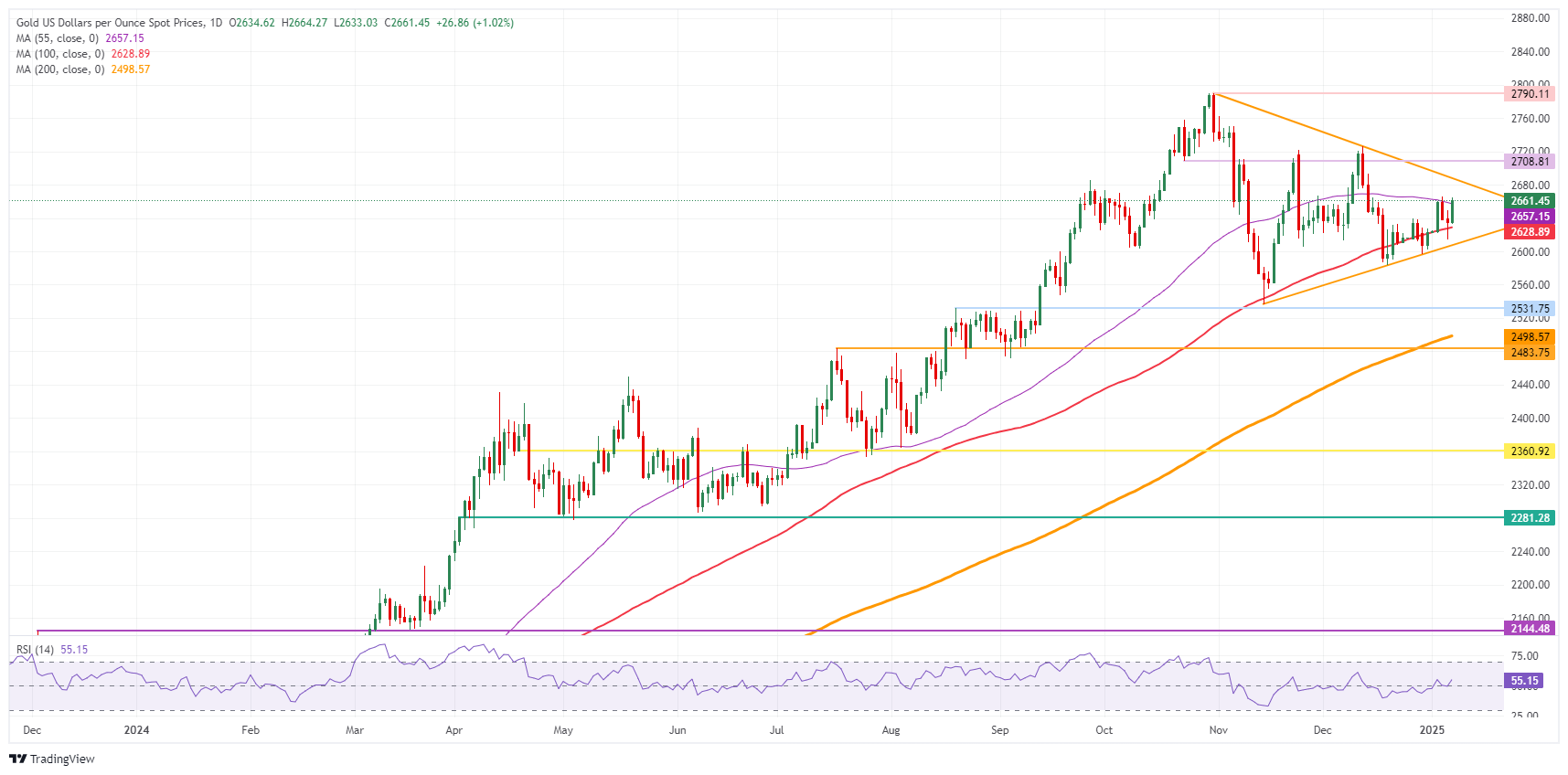Gold price gains after ISM reveals Services inflation is picking up again
- Markets are bracing for a chunky few debt issuance this week in the US.
- Fed interest rate projections see a cut in January out of the cards at the moment, ahead of the FOMC Minutes later this week.
- Gold price is moving within a pennant technical formation, respecting both upside and downside.
Gold’s price (XAU/USD) is heading higher after markets decided to zoom in on the US debt issuances that are set to rock the bond markets this week with a chunky 10-year and 30-year bond allocation. Traders are starting to get concerned if the vast amount of debt and sizes are not becoming a risk where more premium will need to be paid (higher rates) to get the issuances allocated. Markets remain on edge as well meanwhile over the recent string of comments and headlines about the US tariff plans that President-elect Donald Trump wants to impose.
For a brief moment, there was a sigh of relief on Monday after the Washington Post shared a piece claiming that Trump was considering imposing a simple universal tariff on critical imports. After President-elect Trump quickly pushed back against those headlines, Gold’s price returned to levels where it opened the week.
The release from the Institute for Supply Management (ISM) on the Services Sector confirmed the case for traders to focus on rates. The report revealed that Prices Paid in the Services sector jump higher to 64.4, above the expected 57.5 and the previous 58.2 for the month of December. Immediate thereafter the Greenback gained, while yields rallied and odds for a first rate cut from the Federal Reserve were pushed back to July at earlierst.
Daily digest market movers: Inflation to turn hot again
- Inflation data from several European countries and the overall Eurozone shows that the European disinflation path is being broken up, with monthly gauges tied back up with inflation. This could throw a spanner in the works for the European Central Bank (ECB), which is foreseen to cut its policy rate by 25 basis points on January 30.
- The US 10-year yield rallies to 4.68% a fresh eight-month high, fueled by inflation concerns after the ISM Services release.
- The CME Fedwatch tool is currently only showing a small 10% chance for a 25 basis points (bps) interest rate cut in January. Further on, expectations are for the Fed to remain data-dependent with uncertainties that could influence the inflation path once President-elect Donald Trump takes office on January 20.
- In the runup to the US Employment report on Friday, the JOLTS Job Openings for November are due at 15:00 GMT on Tuesday. The Institute for Supply Management (ISM) will also issue its December Purchasing Managers Index (PMI)report on the Services sector.
- The US Treasury will allocate a 3-year bond this Tuesday near 18:00 GMT. The very important 10-year bond auction is foreseen for Wednesday around 18:00 GMT.
Technical Analysis: Gold as inflation hedge still works
It seems that the Gold price is sitting on the bench for now. Traders look to be very happy where the precious metal is currently trading. The weaker US Dollar (USD), together with the elevated tensions on tariffs and other geopolitical events, is not triggering any refugees into the safe-haven commodity. Should a clearer pattern emerge, expect a catch-up move in Gold prices.
On the downside, the 100-day Simple Moving Average (SMA) at $2,628 is holding again after a false break on Monday. Further down, the ascending trend line of the pennant pattern should provide support around $2,608 as it did in the past three occasions. In case that support line snaps, a quick decline to $2,531 (August 20, 2024, high) could come back into play as support level.
On the upside, the 55-day SMA at $2,656 is the first level to beat. It will not be an easy task as it was already proved twice last week as a firm resistance. In case it breaks through, $2,688 will be the ultimate upside level in the form of the descending trendline in the pennant formation.

XAU/USD: Daily Chart
Gold FAQs
Gold has played a key role in human’s history as it has been widely used as a store of value and medium of exchange. Currently, apart from its shine and usage for jewelry, the precious metal is widely seen as a safe-haven asset, meaning that it is considered a good investment during turbulent times. Gold is also widely seen as a hedge against inflation and against depreciating currencies as it doesn’t rely on any specific issuer or government.
Central banks are the biggest Gold holders. In their aim to support their currencies in turbulent times, central banks tend to diversify their reserves and buy Gold to improve the perceived strength of the economy and the currency. High Gold reserves can be a source of trust for a country’s solvency. Central banks added 1,136 tonnes of Gold worth around $70 billion to their reserves in 2022, according to data from the World Gold Council. This is the highest yearly purchase since records began. Central banks from emerging economies such as China, India and Turkey are quickly increasing their Gold reserves.
Gold has an inverse correlation with the US Dollar and US Treasuries, which are both major reserve and safe-haven assets. When the Dollar depreciates, Gold tends to rise, enabling investors and central banks to diversify their assets in turbulent times. Gold is also inversely correlated with risk assets. A rally in the stock market tends to weaken Gold price, while sell-offs in riskier markets tend to favor the precious metal.
The price can move due to a wide range of factors. Geopolitical instability or fears of a deep recession can quickly make Gold price escalate due to its safe-haven status. As a yield-less asset, Gold tends to rise with lower interest rates, while higher cost of money usually weighs down on the yellow metal. Still, most moves depend on how the US Dollar (USD) behaves as the asset is priced in dollars (XAU/USD). A strong Dollar tends to keep the price of Gold controlled, whereas a weaker Dollar is likely to push Gold prices up.
Forex News
Keep up with the financial markets, know what's happening and what is affecting the markets with our latest market updates. Analyze market movers, trends and build your trading strategies accordingly.
